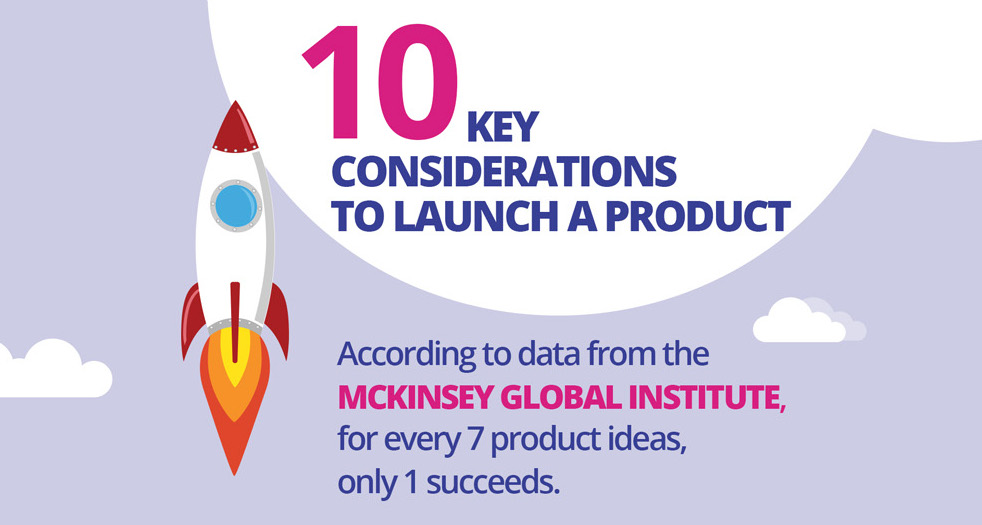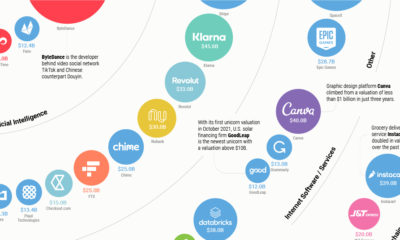Instead, even as we’ve discovered in our planning for the launch of our new “coffee table” book of infographics, it requires an incredible combination of vision, deliberation, teamwork, and project management expertise to accomplish something that’s never been done before. And even if you are lucky enough to nail many of those things, external factors can be just as deadly.
Getting a Launch Right
Today’s infographic comes from To The New, and it details 10 key points to consider before any new product launch. While it has a slant towards technology and startup products, many of the points are relevant for any new endeavor.
The fact is: launching a product can be ripe with pitfalls. Mckinsey says the chance of success for a new product is 14%. That’s why preemptively addressing the most common slipups for new products can be an invaluable step for any prospective entrepreneur.
Ten Areas to Focus On
Here are 10 areas that experts say must be addressed to increase the odds of a successful product launch:
- Market Analysis According to CB Insights, 19% of startup failures were as a result of ignoring competition. Instead, the market potential must be properly analyzed and assessed to give a realistic perspective on a product launch.
- Unclear Requirement and Strategy If expectations for team members are unclear, then it will have a ripple effect. Product development will be delayed, and it could impact timing and profit potential.
- Product Roadmap This high-level plan keeps team members on the same page as product development and the launch are executed.
- Poor Design An easy thing to overlook – product design should be tested with extensive user research. Otherwise, users may not be aware of key features.
- Engineering Best Practices Following best practices for engineering helps to guarantee the product will be ready and glitch-free come launch time.
- Poor Project Management Unrealistic timelines, a lack of communication, and inadequate resource allocation can have a big impact on project success.
- Funding and Capital Getting the right amount of capital is key. Allocating it wisely to ensure project success is just as important.
- Launch Timing Poor timing can also lead to failure. As a result, project scheduling should be carefully planned and thought out, taking into account possible roadblocks or other adverse circumstances that could derail the plan.
- Performance and Usability For software or web-based products in particular: no one wants to deal with long loading times, slow responsiveness, or other usability issues. It’s best to clear these up before the product hits market.
- Availability and Maintenance If the product is connected to the web, the team needs to ensure that servers and security measures are taken to ensure uptime and availability.
A Final Note
Even the most powerful corporations are aware of the many potential pitfalls when launching a new product. It’s why every CEO is so adamant that their organization maintains the focus on their core vision, competitive advantage, and current brand value proposition. If any new product does not fit all this criteria, it’s not worth the risk of the company being distracted. This is true for even the most resourceful and innovative corporations. Luckily, and consequently, this conservatism that permeates big companies is exactly what opens up the tiny window for you to succeed with your next product launch! on But fast forward to the end of last week, and SVB was shuttered by regulators after a panic-induced bank run. So, how exactly did this happen? We dig in below.
Road to a Bank Run
SVB and its customers generally thrived during the low interest rate era, but as rates rose, SVB found itself more exposed to risk than a typical bank. Even so, at the end of 2022, the bank’s balance sheet showed no cause for alarm.
As well, the bank was viewed positively in a number of places. Most Wall Street analyst ratings were overwhelmingly positive on the bank’s stock, and Forbes had just added the bank to its Financial All-Stars list. Outward signs of trouble emerged on Wednesday, March 8th, when SVB surprised investors with news that the bank needed to raise more than $2 billion to shore up its balance sheet. The reaction from prominent venture capitalists was not positive, with Coatue Management, Union Square Ventures, and Peter Thiel’s Founders Fund moving to limit exposure to the 40-year-old bank. The influence of these firms is believed to have added fuel to the fire, and a bank run ensued. Also influencing decision making was the fact that SVB had the highest percentage of uninsured domestic deposits of all big banks. These totaled nearly $152 billion, or about 97% of all deposits. By the end of the day, customers had tried to withdraw $42 billion in deposits.
What Triggered the SVB Collapse?
While the collapse of SVB took place over the course of 44 hours, its roots trace back to the early pandemic years. In 2021, U.S. venture capital-backed companies raised a record $330 billion—double the amount seen in 2020. At the time, interest rates were at rock-bottom levels to help buoy the economy. Matt Levine sums up the situation well: “When interest rates are low everywhere, a dollar in 20 years is about as good as a dollar today, so a startup whose business model is “we will lose money for a decade building artificial intelligence, and then rake in lots of money in the far future” sounds pretty good. When interest rates are higher, a dollar today is better than a dollar tomorrow, so investors want cash flows. When interest rates were low for a long time, and suddenly become high, all the money that was rushing to your customers is suddenly cut off.” Source: Pitchbook Why is this important? During this time, SVB received billions of dollars from these venture-backed clients. In one year alone, their deposits increased 100%. They took these funds and invested them in longer-term bonds. As a result, this created a dangerous trap as the company expected rates would remain low. During this time, SVB invested in bonds at the top of the market. As interest rates rose higher and bond prices declined, SVB started taking major losses on their long-term bond holdings.
Losses Fueling a Liquidity Crunch
When SVB reported its fourth quarter results in early 2023, Moody’s Investor Service, a credit rating agency took notice. In early March, it said that SVB was at high risk for a downgrade due to its significant unrealized losses. In response, SVB looked to sell $2 billion of its investments at a loss to help boost liquidity for its struggling balance sheet. Soon, more hedge funds and venture investors realized SVB could be on thin ice. Depositors withdrew funds in droves, spurring a liquidity squeeze and prompting California regulators and the FDIC to step in and shut down the bank.
What Happens Now?
While much of SVB’s activity was focused on the tech sector, the bank’s shocking collapse has rattled a financial sector that is already on edge.
The four biggest U.S. banks lost a combined $52 billion the day before the SVB collapse. On Friday, other banking stocks saw double-digit drops, including Signature Bank (-23%), First Republic (-15%), and Silvergate Capital (-11%).
Source: Morningstar Direct. *Represents March 9 data, trading halted on March 10.
When the dust settles, it’s hard to predict the ripple effects that will emerge from this dramatic event. For investors, the Secretary of the Treasury Janet Yellen announced confidence in the banking system remaining resilient, noting that regulators have the proper tools in response to the issue.
But others have seen trouble brewing as far back as 2020 (or earlier) when commercial banking assets were skyrocketing and banks were buying bonds when rates were low.

















